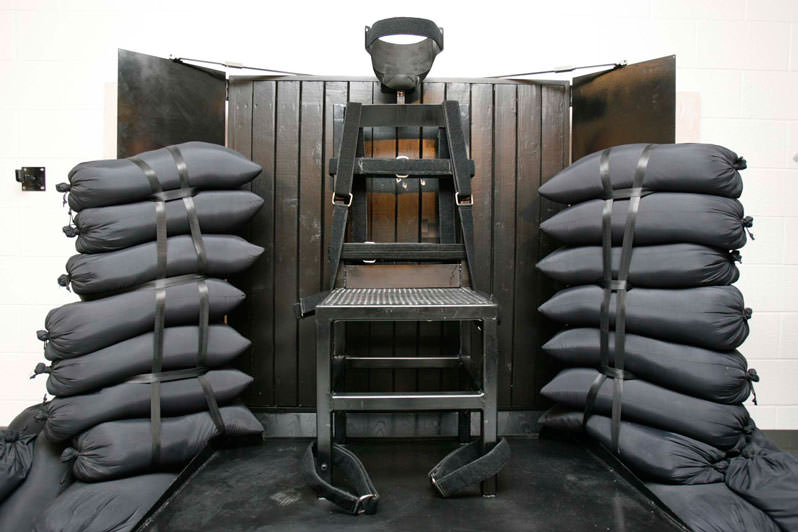A Simple Fix for Our Execution Problem
Shortages of lethal drugs are causing executions to be botched in horrible ways, but the resulting public outcry could help clear a path to a lasting, moral solution. The firing squad execution chamber at the Utah State Prison in Draper, Utah. State Rep. Paul Ray hopes to bring back firing squads to take the place of lethal injections. AP/Trent Nelson
The firing squad execution chamber at the Utah State Prison in Draper, Utah. State Rep. Paul Ray hopes to bring back firing squads to take the place of lethal injections. AP Photo/Trent Nelson
The firing squad execution chamber at the Utah State Prison in Draper, Utah. State Rep. Paul Ray hopes to bring back firing squads to take the place of lethal injections. AP Photo/Trent Nelson
The firing squad execution chamber at the Utah State Prison in Draper, Utah. State Rep. Paul Ray hopes to bring back firing squads to take the place of lethal injections. AP Photo/Trent Nelson
The firing squad execution chamber at the Utah State Prison in Draper, Utah. State Rep. Paul Ray hopes to bring back firing squads to take the place of lethal injections. AP/Trent Nelson
The firing squad execution chamber at the Utah State Prison in Draper, Utah. State Rep. Paul Ray hopes to bring back firing squads to take the place of lethal injections. AP Photo/Trent Nelson
The firing squad execution chamber at the Utah State Prison in Draper, Utah. State Rep. Paul Ray hopes to bring back firing squads to take the place of lethal injections. AP Photo/Trent Nelson
The firing squad execution chamber at the Utah State Prison in Draper, Utah. State Rep. Paul Ray hopes to bring back firing squads to take the place of lethal injections. AP Photo/Trent Nelson
What happens in prison death chambers is something most Americans dislike thinking about. But amid news of our executioners bungling as the materials of their craft grow ever more scarce, of officials scrambling to bring back old methods of execution, of outcries from capital-punishment opponents, it is almost impossible to avoid being mentally drawn into those small rooms where lives are extinguished.
Last Thursday the governor of Tennessee signed a bill requiring that condemned criminals be executed by electric chair if the state did not have the means to conduct lethal injections. “… [A] brutal alternative” was the response of Richard Dieter, executive director of the Death Penalty Information Center.
On the same day it was reported that Wyoming state legislators were considering a change that would permit firing-squad executions. State Rep. Stephen Watt, who was shot as he was working as a Wyoming Highway Patrol trooper, opposed the move: “… I don’t care how quickly death comes from firing squad. It still hurts and it’s still terrifying. And I think it’s cruel and unusual.”
In January a bill was introduced in the Missouri Legislature that would add a firing-squad option. Claire McCaskill, a U.S. senator from Missouri, tweeted in reaction: “Not my state’s finest moment.”
In February a new bill in the Louisiana House sought to have the electric chair as an option. But there’s a problem — the state does not have a working electric chair. The one that was used for decades is a museum piece at the Angola penitentiary.
Going back to the electric chair in the second decade of the 21st century? Restoring the firing squad? It’s as if sectors of American officialdom, dead set on having ways to continue to kill some of our citizens, are marching rearward into a harsher phase of history.
Public rumbling over the death penalty is on the rise. Early this month, the CNN website published an article that said:
A botched lethal injection in Oklahoma [the Clayton Lockett execution] has catapulted the issue of U.S. capital punishment back into the international spotlight, raising new questions about the drugs being used and the constitutional protection against cruel and unusual punishment. …
What went wrong [April 29] in Oklahoma “will not only cause officials in that state to review carefully their execution procedures and methods,” said Richard W. Garnett, a former Supreme Court law clerk who now teaches criminal and constitutional law at the University of Notre Dame, “it will also almost prompt many Americans across the country to rethink the wisdom, and the morality, of capital punishment.”
It’s unfortunate that the cause of the upsurge in public attention is a series of executions that went wrong, but, as we will see later, the situation may offer an opening for change.
Here’s a quick look at bits of background and at the events and forces that are shaking the American way of government-sanctioned death.
— — —
Lethal injection is the normal form of execution in more than 30 states, and more than 1,200 convicts have been dispatched by that method since 1976. Some states authorize other ways of execution under certain circumstances. Eighteen states have abolished the death penalty.
Over recent decades a high percentage of U.S. executions have used lethal injection, usually employing three drugs in sequence — sodium thiopental, pancuronium bromide and potassium chloride. The first quickly produces deep unconsciousness and in high concentrations can kill; the second is a muscle relaxant that can produce fatal paralysis in high doses; the third quickly stops the heart. This standard protocol was created in 1977 by Dr. Jay Chapman, a physician and forensic pathologist who then was chief medical examiner for the state of Oklahoma.
In the last few years executioners have had great difficulty in getting the drugs they want, especially sodium thiopental. U.S. and foreign sources of this and other execution drugs began drying up in 2011 under pressure on suppliers from an international campaign against capital punishment. Dieter said last year: “Many states will have to change their method of execution, which means regulatory changes that have to be approved and lengthy court challenges. In many states, this could take months, if not years, delaying executions.”
The situation has caused states to look to other chemicals. Some states, such as Ohio, are now using two drugs instead of the usual three. “In the old three-drug combination, each drug was being used for what it was designed for,” Jonathan Groner, a clinical surgery professor at Ohio State University, said. “But Ohio is taking drugs that are normally used for things like a colonoscopy, and they’re giving massive overdoses to kill people. They’re using them for their toxic side effects.”
— — —
Clayton Darrell Lockett died of a heart attack last month. He was 38 years old.
Not many mourned, for Lockett was no angel. The word “devil” was what came to mind for some people who read about his crimes, which included having a teenager buried alive.
The firing squad execution chamber at the Utah State Prison in Draper, Utah. State Rep. Paul Ray hopes to bring back firing squads to take the place of lethal injections. AP Photo/Trent Nelson
In 1999 Lockett, nursing a grievance over a tiny debt he felt he was owed by Bobby Lee Bornt, set out with his 17-year-old cousin and another man to rob Bornt’s home in Perry, Okla. Within hours the three had committed a number of horrific crimes:
— They tied up and beat Bornt in the presence of his 9-month-old son. (They later made a decision not to kill the child and went to considerable lengths to take care of him.)
— They beat an 18-year-old woman and Stephanie Neiman, 19, both of whom showed up at the house. Lockett raped the 18-year-old “vaginally and anally and he made her perform oral sodomy on him,” according to an Oklahoma appeals court summary quoted in a brief by the state attorney general,
— Lockett and his accomplices then kidnapped Bornt, the two women and the baby.
— On a country road, Lockett made the 18-year-old “go with him to a ditch where he raped her and forced her to perform oral sex on him,” the appeals court summary said.
— After Neiman refused to promise to keep quiet about what Lockett and his two friends had done, Lockett shot her twice near a hastily dug grave. Later, during a detailed, matter-of-fact confession, he would say she survived the sawed-off shotgun blasts and that she was buried alive. “I could see her coughing, I could see the dirt coming in the air,” he said.
Bornt and the surviving woman, after they and the baby were freed, went to the authorities, who did not take long to arrest Lockett and his partners.
In August of 2000, Lockett — who had a history of previous felonies — was convicted of murder, conspiracy, first-degree burglary, three counts of assault with a dangerous weapon, three counts of forcible oral sodomy, four counts of first-degree rape, four counts of kidnapping and two counts of robbery by force and fear. He was sentenced to be executed, and for the non-capital counts he received prison terms totaling 2,285 years and 90 days.
During the years Lockett was in prison after his conviction he showed no signs of reforming. He often was in trouble; shanks were found in his possession. He wrote in a letter, “In reality I am probably the most dangerous type of criminal … ’cause I’m an assassin — point blank!” Early on the day of his execution, April 29, Lockett resisted a prison staff attempt to take him from his cell for X-rays, and as a result an extraction team shot him with a Taser.
Some people in Oklahoma and elsewhere who knew the facts figured that if anyone ever deserved to be executed, it was Clayton Lockett.
With the Lockett execution looming, shortages of the traditional drugs forced Oklahoma to change its lethal chemicals. Although three drugs were to be used, the state replaced two of the three in the standard protocol.
The outcome was not pretty. Here is a timeline based partly on a report by Ziva Branstetter, the enterprise editor of the Tulsa World.
— At 6:23 p.m. the order to begin the execution is given.
— At 6:31 a doctor checks and says, “Mr. Lockett is not unconscious.” “I’m not,” Lockett says.
— At 6:33 the physician declares him unconscious.
— At 6:36 Lockett’s right leg kicks, his head rolls to one side and he mumbles.
— At 6:37 he writhes and bucks and seems to be trying to sit up against the restraints. Again he says something that is unintelligible.
— At 6:38 he grimaces, grunts and lifts his upper body from the gurney. He says something that includes the exclamation “Man!”
— At 6:39 Warden Anita Trammell, present at the execution, announces that the blinds between the execution room and the observation room will be lowered.
— At about 6:50 Department of Corrections Director Robert Patton tells those in the viewing area that the execution has been stopped. “We’ve had a vein failure in which the chemicals did not make it into the offender,” he says.
— At 7:06 Lockett is pronounced dead of a heart attack in the execution chamber.
It turns out that it had taken 51 minutes to find a vein through which to inject the drugs. Eventually an intravenous line was connected to Lockett’s groin.
After the execution Oklahoma continued to deflect blame from the efficacy of the drugs, saying instead they simply did not fully enter Lockett’s bloodstream. “The drugs had either absorbed into tissue, leaked out or both,” Patton wrote in a letter to the governor. “The director asked the following question, ‘Have enough drugs been administered to cause death?’ The doctor responded, ‘No.’ “
No more drugs had been available in the death chamber.
Branstetter, one of 12 media witnesses at the execution, said in a video interview: “It took quite a long time for Clayton Lockett to become unconscious, about 10 minutes. … He for about three minutes writhed in pain violently. … He was grimacing and writhing in pain. … This was very, very different from any other executions I witnessed. … We were all shaken … it was very unsettling.”
The day after Lockett died, White House press secretary Jay Carney said that although President Barack Obama thinks the death penalty is warranted in some cases, “we have a fundamental standard in this country that even when the death penalty is justified, it must be carried out humanely.” He added, “And I think everyone would recognize that this case [the Lockett execution] fell short of that standard.”
After Lockett was dead at the hand of Oklahoma, some people said that whatever torment this criminal suffered in the prison’s killing room was not painful enough. But others felt that no human, however evil his deeds, ever should be tortured to death by American authorities.
— — —
In an Ohio execution Jan. 16, Dennis McGuire gasped for air for 10 minutes or more. Here is part of an account written by a Catholic priest who witnessed the 26-minute execution, in which an experimental two-drug combination was used.
At about 10.31am, his stomach swelled up in an unusual way, as though he had a hernia or something like that. Between 10.33am and 10.44am — I could see a clock on the wall of the death house — he struggled and gasped audibly for air.
I was aghast. Over those 11 minutes or more he was fighting for breath, and I could see both of his fists were clenched the entire time. His gasps could be heard through the glass wall that separated us. Towards the end, the gasping faded into small puffs of his mouth. It was much like a fish lying along the shore puffing for that one gasp of air that would allow it to breathe. Time dragged on and I was helpless to do anything, sitting helplessly by as he struggled for breath. I desperately wanted out of that room.
Before the execution, attorneys for McGuire had hired an anesthesiologist who predicted he would experience something called air hunger, which would, in the words of the lawyers, cause “agony and terror.” An anesthesiologist for the state of Ohio disagreed with that assertion.
McGuire’s family is suing the maker of the drugs used, alleging they caused the condemned man to suffer severely and needlessly.
— — —
The last words of Michael Lee Wilson during an Oklahoma execution in January: “I feel my whole body burning.”
— — —
Over the last hundred years the methods of execution in the United States, in addition to lethal injection, have been hanging, shooting by firing squad, electrocution and gassing. Botched executions have occurred in each of these categories. In the face of the current shortage of execution drugs, simply switching to hanging, firing squad, electrocution or gassing would offer no guarantee against inhumane killing of condemned felons.
Two hundred seventy-six executions in the United States between 1890 and 2010 — more than 3 percent — were bungled, according to a new book, “Gruesome Spectacles: Botched Executions and America’s Death Penalty,” by Austin Sarat, a professor of jurisprudence and political science at Amherst College. His research puts the rate of botched executions between 1980 and 2010 at 8.53 percent.
In an interview with Wired magazine, Sarat talked in part about the history of executions and what could go wrong. Of hanging he said: “… it is supposed to break the neck. If you don’t get the drop right, there are at least two possible adverse consequences. One is that the condemned slowly strangles. The other, which is more rare but does happen, is that the condemned is decapitated.”
One example of the last development, cited in another source, was the 1930 execution of the first woman to be hanged by Arizona authorities. When she dropped from the gallows, her head was ripped off. An 1876 newspaper article tells of an Ohio hanging in which a 19-year-old survived when the rope broke. He remained conscious — and in great fear. He was quickly put back on the gallows, and the hangman had better luck the second time around.
In 1946, a 17-year-old was severely shocked in a visit to the Louisiana electric chair but survived. Afterward, he was returned to his prison cell. A new death warrant was issued and a court found that putting him in the chair again would not violate the Constitution’s prohibition against cruel and unusual punishment. The chair did its job when the convict was put back in it. In Virginia in 1982, the head and a leg of the condemned man caught fire when a second jolt of electricity was applied. A 1983 Alabama electrocution took 14 minutes and left the body smoldering.
In another 1983 execution, this one in Mississippi, the convict begin to moan and strike his head against a metal bar behind the gas chamber chair. The sight was so gruesome that officials cleared the observation room.
The firing squad execution chamber at the Utah State Prison in Draper, Utah. State Rep. Paul Ray hopes to bring back firing squads to take the place of lethal injections. AP Photo/Trent Nelson
A 1996 article in The Salt Lake Tribune told of a 1951 firing squad execution in which two of the four bullets missed the heart of the target, instead striking him in the abdomen and hip. A witness was quoted as saying he “died silently and horribly.”
— — —
It appears that our accepted means of killing condemned inmates work as intended for the most part but that they are far from infallible. Even a casual glance at the history of U.S. executions shows that an unacceptable fraction of those we kill are subjected to conditions in the last moments of their lives that many reasonable Americans would see as cruel and unusual. I cannot speak as a judge, lawyer, ethicist, physician or penologist; I can speak only as a layman who cannot escape the conclusion that it is morally wrong to kill convicts in highly painful ways, regardless of what they have done. Many authoritative parties argue that capital punishment itself is not constitutional. The American Civil Liberties Union declares that capital punishment “violates the constitutional ban against cruel and unusual punishment and the guarantees of due process of law and of equal protection under the law.” It goes on to say, “The death penalty is a waste of taxpayer funds and has no public safety benefit.”
No less a judicial luminary than U.S. Supreme Court Justice William Brennan wrote this in a 1976 dissent, in which he quotes liberally:
Death is not only an unusually severe punishment, unusual in its pain, in its finality, and in its enormity, but it serves no penal purpose more effectively than a less severe punishment. … The fatal constitutional infirmity in the punishment of death is that it treats “members of the human race as nonhumans, as objects to be toyed with and discarded. [It is] thus inconsistent with the fundamental premise of the [Cruel and Unusual Punishments] Clause that even the vilest criminal remains a human being possessed of common human dignity.” As such it is a penalty that “subjects the individual to a fate forbidden by the principle of civilized treatment guaranteed by the [Clause].” I therefore would hold, on that ground alone, that death is today a cruel and unusual punishment prohibited by the Clause. … I would set aside the death sentences imposed … as violative of the Eighth and Fourteenth Amendments.”
— — —
Here’s a radical proposal: Let’s get out of the business of killing criminals. About 70 percent of the world’s countries have abolished the death penalty or do not use it, and they do not seem to suffer as a consequence.
There is no shortage of arguments against the death penalty. Consider the propositions that innocent people are sometimes executed, that death sentences are arbitrary and capricious, that members of racial and ethnic minorities are disproportionately subjected to capital punishment, that capital punishment is far costlier than imprisonment and that the long appeal process psychologically tortures those on death row.
It would be naive to think that states that retain execution laws will vote to abolish the death penalty just because drug shortages are causing problems in death chambers. A majority of Americans remain in favor of capital punishment. The arguments for execution are passionate and deeply set, especially among cultural conservatives. A Gallup Poll report in late 2013 showed 60 percent of Americans favoring the death penalty. A Gallup survey in early 2013 that took political leanings into consideration found 75 percent of conservatives were in favor of capital punishment, as opposed to 47 percent of liberals.
However, there are signs that the sun is starting to set on the day of government-sanctioned killing of inmates in the United States. From the mid-1990s to 2013, the percentage of Americans in favor of capital punishment dropped 20 points, and Gallup said that the 60 percent figure in 2013 was the lowest in more than 40 years.
The number of executions generally has moved downward since the late 1990s — from 98 in 1999 to 43 in both 2011 and 2012, and to 39 in 2013. The decline may be driven mostly by homicide rate reductions, demographic trends and other factors in addition to the lethal-drug shortage. Even so, there is a rising reluctance among Americans — and seemingly among judges — to see the death penalty imposed. Nation.time.com says, “The decline [in the number of executions] reflects growing sentiment among Americans to end capital punishment.” With more than a third of the states already having abolished executions, and with six states having eliminated the death penalty since 2007, the outcry over the executions of Lockett and others since 2011 promises to hasten the shift toward abolition.
The controversies over botched executions, and the resulting climb in public attention paid to executions, could help open a door for U.S. foes of capital punishment. Groups that formally oppose capital punishment or are generally seen as being against it include the American Civil Liberties Union, Amnesty International, the California Innocence Project, the Death Penalty Information Center, the Campaign to End the Death Penalty, the National Coalition to Abolish the Death Penalty, Equal Justice USA, Citizens United for Alternatives to the Death Penalty, Murder Victims’ Families for Reconciliation, Catholics Against Capital Punishment and People of Faith Against the Death Penalty. This may be an extraordinary opportunity for them to make their case to a news-consuming public that currently cannot avoid the capital-punishment issue. Their message could strike home with unprecedented effectiveness, expanding support for abolition.
The gains made by opponents of the death penalty are likely to be limited, but such changes are nonetheless important. Although abolition will not come overnight, I think it is just as inevitable as fairer treatment was at one time for African-Americans and gays and lesbians. To rework a line from Martin Luther King: The arc of the moral universe is long, but it bends toward governmental respect for life.
In 2014, it’s time to move away from Bronze Age notions of eye-for-an-eye vengeance. Just say no to barbarism. It’s a simple, permanent fix for our execution problem.
Your support matters…Independent journalism is under threat and overshadowed by heavily funded mainstream media.
You can help level the playing field. Become a member.
Your tax-deductible contribution keeps us digging beneath the headlines to give you thought-provoking, investigative reporting and analysis that unearths what's really happening- without compromise.
Give today to support our courageous, independent journalists.






You need to be a supporter to comment.
There are currently no responses to this article.
Be the first to respond.